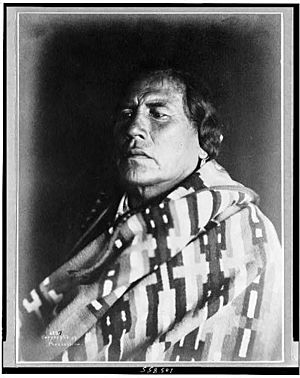Richard Throssel facts for kids

Richard Throssel (1882–1933) was a talented photographer from the Cree people. He is famous for taking pictures of daily life on the Crow Reservation in the early 1900s. His photos show important moments and beautiful scenes of the Crow people.
Richard Throssel's Early Life and Connection to the Crow Nation
Richard Throssel was born in Marengo, Washington in 1882. When he was 20, he moved to the Crow Reservation in Montana. He had a health issue called rheumatism, and doctors suggested a drier place to live. He worked there as a clerk for the Indian Services office.
Even though Throssel was not Crow, he had some Cree heritage from Canada. In 1906, the Crow Nation adopted him into their community. This special connection allowed him to take very personal and close-up photos that other photographers couldn't.
While on the reservation, Throssel saw amazing art. He saw beautiful Crow beading and special drawings called ledger art. He also saw paintings and photos by other artists like Joseph Henry Sharp and Edward S. Curtis. Throssel took painting lessons from Sharp. He learned how to create art and how to arrange things in a picture.
Throssel's Photography Career
Throssel started taking pictures soon after he arrived at the Crow Reservation. By 1905, he had sent 29 of his photos to be officially copyrighted. In the same year, he met Edward S. Curtis, who was also an ethnographer and photographer.
Curtis's style influenced Throssel's later photos. In 1907, Throssel's pictures often used bright lighting and sometimes showed arranged scenes. This gave his photos a more emotional and artistic feel. Throssel was also known for his photos of Crow couples, families, and children. These pictures are special because they show the love and warmth within families. This was different from how Native people were often shown in early photography.
Throssel's photos felt very real and familiar. You could see a sense of connection in the people he photographed. This was something other non-Native photographers often missed.
Throssel continued to photograph the Crow Nation for the Wanamaker Expedition in 1908. He also worked for the Indian Service in 1909. After leaving the Indian Service, Throssel and his wife moved to Billings, Montana. There, he opened his own photography business called The Throssel Photographic Company. He created a famous brochure of his photos called Western Classics.
In less than ten years, Throssel collected almost 1,000 photographs. This included 180 portraits of Crow people and 99 portraits of other American Indians. He also took 186 pictures of tipis, 63 photos of Crow ceremonies, and 352 pictures of daily life among the Crows in Montana.
After a successful career as an artist, Throssel became involved in politics. In 1917, he was elected twice to represent Yellowstone County in the Montana Legislature. Throssel remained interested in politics until he passed away in 1933.

